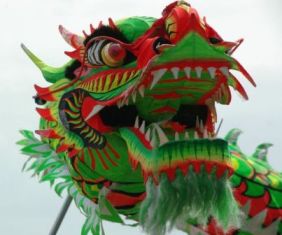Back to Holidays
Holidays
Chinese New Year
 Caseman, Pd, via Wikimedia
Caseman, Pd, via Wikimedia
What does Chinese New Year celebrate?
The Chinese New Year celebrates the first day of the first month on the Chinese calendar. It is also called the Spring Festival and is the most important of the traditional Chinese holidays.
When is Chinese New Year celebrated?
The Chinese New Year occurs on the first day of the Chinese lunar-solar calendar. The celebration lasts until the 15th day which is also the day of the Lantern Festival.
The dates according to the Western calendar of the Chinese New Year move each year, but always land between January 21st and February 20th. Each year also has an animal associated with it. Here are some of the dates as well as the animals associated with that year:
- 2010-02-14 Tiger
- 2011-02-03 Rabbit
- 2012-01-23 Dragon
- 2013-02-10 Snake
- 2014-01-31 Horse
- 2015-02-19 Goat
- 2016-02-08 Monkey
- 2017-01-28 Rooster
- 2018-02-16 Dog
- 2019-02-05 Pig
- 2020-01-25 Rat
- 2021-02-12 Ox
Who celebrates this day?
This day is celebrated by all of China as well as Chinese people throughout the world.
What do people do to celebrate?
The entire first week is usually a national holiday in China. Many people take vacations for the week. The largest celebration is on the night before the start of the Chinese New Year. This night is celebrated with parties and fireworks.
The New Year is also an important time for the Chinese to celebrate family and to honor their elders such as parents and grandparents.
There are a number of traditions celebrated during Chinese New Year:
- Dragon Dance or Lion Dance - These dances are often a part of parades and festivities during the holiday. In a dragon dance a large team of people (up to 50) carry portions of the dragon on poles and move the poles in a manner that depicts the movement of the dragon. In a lion dance two people dress in an elaborate lion costume and move and dance to mimic a lion.
- Red Envelopes - Red envelopes filled with money are often handed out as presents to young children or newly married couples. An even amount of money is given for good luck.
- Cleaning the house - Chinese families generally clean their house thoroughly before any celebrations in order get rid of any of last year's bad luck.
- Firecrackers - A traditional part of the celebration is to light a lot firecrackers. The Ancient Chinese believed that the loud noise would scare off evil spirits. In some places, like Hong Kong, lighting real firecrackers has been banned. As a result, many people decorate their homes with colorful plastic firecrackers.
- The color red - The color red is the main color for clothes and decorations. It symbolizes joy and happiness.
History of Chinese New Year
The Chinese New Year has been celebrated in China for thousands of years. The original story tells of a lion-like monster named Nian that terrorized Chinese villagers. One year, a wise monk advised the villagers to use loud noises along with red paper cutouts hung over their doors to scare Nian away. This worked and the villagers were able to defeat Nian. The day that Nian was defeated became the start of the New Year.
In 1912 the Chinese government moved to the western Gregorian calendar. Because January 1st was now the start of the year, they changed the name of Chinese New Year to the Spring Festival. In 1949, when Mao Zedong founded the People's Republic of China, he felt the celebration as too religious. As a result, the holiday wasn't celebrated on mainland China for many years. However, with reforms in the late 1980s, the festival was resumed. Today it is once again the most popular holiday in China.
Fun Facts About Chinese New Year
- The dragon represents prosperity, good fortune, and good luck.
- Certain fruits and flowers are considered lucky such as tangerines, peach blossoms, and kumquat trees.
- One popular greeting on this day is Kung Hei Fat Choy meaning "We hope you get rich".
- Firecrackers are often set off on the fifth day of the celebration to gain the attention of the god of prosperity.
- It is considered by some to be bad luck to use fire, a knife, or a broom on the first day of the New Year.
- The holiday is celebrated in several Chinatowns in cities across the United States such as New York City, Chicago, and San Francisco.
February Holidays
Chinese New Year
National Freedom Day
Groundhog Day
Valentine's Day
President's Day
Mardi Gras
Ash Wednesday
Back to Holidays
